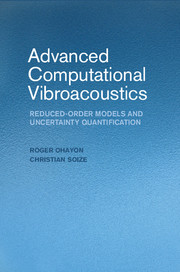Book contents
- Frontmatter
- Contents
- 1 Principal Objectives and a Strategy for Modeling Vibroacoustic Systems
- 2 Definition of the Vibroacoustic System
- 3 External Inviscid Acoustic Fluid Equations
- 4 Internal Dissipative Acoustic Fluid Equations
- 5 Structure Equations
- 6 Vibroacoustic Boundary Value Problem
- 7 Computational Vibroacoustic Model
- 8 Reduced-Order Computational Model
- 9 Uncertainty Quantification in Computational Vibroacoustics
- 10 Symmetric BEM without Spurious Frequencies for the External Acoustic Fluid
- References
- Glossary
- Author Index
- Subject Index
4 - Internal Dissipative Acoustic Fluid Equations
Published online by Cambridge University Press: 05 August 2014
- Frontmatter
- Contents
- 1 Principal Objectives and a Strategy for Modeling Vibroacoustic Systems
- 2 Definition of the Vibroacoustic System
- 3 External Inviscid Acoustic Fluid Equations
- 4 Internal Dissipative Acoustic Fluid Equations
- 5 Structure Equations
- 6 Vibroacoustic Boundary Value Problem
- 7 Computational Vibroacoustic Model
- 8 Reduced-Order Computational Model
- 9 Uncertainty Quantification in Computational Vibroacoustics
- 10 Symmetric BEM without Spurious Frequencies for the External Acoustic Fluid
- References
- Glossary
- Author Index
- Subject Index
Summary
This chapter is devoted to the description of the equations in terms of the pressure field and the associated boundary conditions for the internal dissipative acoustic fluid of the vibroacoustic system. A wall acoustic impedance can be taken into account. In the last section, the case of a free surface for a compressible liquid is considered.
EQUATIONS IN THE FREQUENCY DOMAIN
As introduced in Section 2.3, the fluid is assumed to be homogeneous, compressible, and dissipative. In the reference configuration, the fluid is supposed to be at rest. The fluid is either a gas or a liquid and gravity effects are neglected (see Andrianarison and Ohayon, 2006, to take into account both gravity and compressibility effects for an inviscid internal fluid). Such a fluid is called a dissipative acoustic fluid. Generally, there are two main physical dissipations. The first one is an internal acoustic dissipation inside the cavity due to the viscosity and the thermal conduction of the fluid. These dissipation mechanisms are assumed to be small. In the model proposed, we consider only the dissipation due to the viscosity. This correction introduces an additional dissipative term in the Helmholtz equation without modifying the conservative part. The second one is the dissipation generated inside the wall viscothermal boundary layer of the cavity and is neglected here. We then consider only the acoustic mode (irrotational motion) predominant in the volume.
Information
- Type
- Chapter
- Information
- Advanced Computational VibroacousticsReduced-Order Models and Uncertainty Quantification, pp. 24 - 28Publisher: Cambridge University PressPrint publication year: 2014
